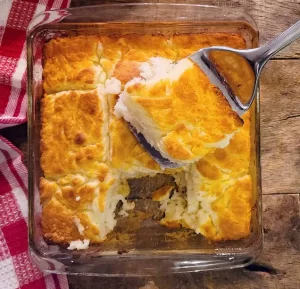Last Updated on May 5, 2025 by recipeinspire
Table of Contents
Why Butter Needs to be Cold for Biscuits: The Science Behind Perfectly Flaky Pastries

Why Butter Needs to be Cold for Biscuits? ,Butter is a key ingredient in biscuit recipes, but have you ever wondered why it needs to be cold? The temperature of butter can impact the texture and taste of biscuits, making it an important factor in achieving the perfect flaky layers and buttery flavor.
When butter is cold, it creates small pockets of fat in the dough, which melt during baking and create steam. This steam helps to create the flaky layers that are characteristic of a good biscuit. If the butter is too warm, it will incorporate into the dry ingredients and lose its ability to create these pockets of steam.
Understanding the role of cold butter in biscuits is essential for achieving the perfect texture and flavor. In this article, we will explore the science behind why butter needs to be cold, methods for keeping butter cold, and common mistakes to avoid.
Key Takeaways
- Cold butter is essential for creating flaky layers in biscuits.
- The pockets of fat created by cold butter melt during baking and create steam, which helps to create the flaky texture.
- Keeping butter cold and avoiding common mistakes can help to ensure the perfect biscuit every time.
Related Posts:
Understanding the Role of Butter in Biscuits
Butter is an essential ingredient in making biscuits. It contributes to the flavor, texture, and structure of the biscuits. One of the most critical aspects of using butter in biscuits is to ensure that it is cold.
When making biscuits, the cold butter gets cut into the flour mixture, creating small pockets of fat. When the biscuits bake, the fat melts, creating steam and producing a flaky texture. If the butter is not cold, it will melt too quickly, resulting in dense and tough biscuits.
Butter also adds flavor to the biscuits. The richness and creaminess of butter cannot be duplicated by other fats. It is important to use real butter in biscuit recipes for the best flavor.
Another reason to use cold butter is to prevent gluten formation. Gluten is a protein that forms when flour is mixed with liquid. Gluten development can make biscuits tough and chewy. By using cold butter, the flour mixture remains crumbly, preventing gluten from forming.
Overall, using cold butter is crucial in making delicious and flaky biscuits. It is important to follow the recipe instructions and use cold butter to achieve the best results.
Related Posts:
The Science Behind Cold Butter
When making biscuits, using cold butter is a crucial step that should not be skipped. The temperature of the butter can affect the texture and structure of the dough and the final product. In this section, we will explore the science behind why cold butter is necessary for making biscuits.
Cold Butter Vs. Room Temperature Butter
Butter is an emulsion of water, fat, and milk solids. When butter is at room temperature, the fat molecules are soft and pliable, making it easier to mix with other ingredients. However, this also means that the fat can easily melt and become absorbed into the flour, resulting in a dense and tough biscuit.
On the other hand, when butter is cold, the fat molecules are solid and firm. This makes it harder for the fat to mix with the flour, resulting in a flakier and crumbly texture. Additionally, the cold butter will create pockets of steam as it melts in the oven, causing the biscuit to rise and become airy.
How Cold Butter Affects Dough Structure
When cold butter is cut into the flour, it creates small pockets of fat that are coated in flour. These pockets of fat are what create the flaky layers in biscuits. As the biscuits bake, the cold butter melts and creates steam, which lifts and separates the layers of dough.
If the butter is too warm, it will not create these pockets of fat, resulting in a dense and tough biscuit. However, if the butter is too cold, it will not mix well with the flour and can result in uneven pockets of fat, creating a lumpy texture.
In conclusion, using cold butter is essential for making flaky and tender biscuits. It is important to keep the butter as cold as possible while cutting it into the flour, and to work quickly to prevent the butter from melting. By understanding the science behind cold butter, you can achieve perfect biscuits every time.
The Impact of Cold Butter on Biscuit Quality
When making biscuits, the temperature of the butter used in the recipe can have a significant impact on the final product’s quality. Cold butter is a key ingredient that can make the difference between a perfect biscuit and a mediocre one. Here are some of the ways that cold butter affects biscuit quality.
Flakiness
One of the most desirable characteristics of a biscuit is its flakiness. Cold butter helps to achieve this by creating layers of fat that melt in the oven, creating pockets of air that give the biscuit its flaky texture. When butter is at room temperature or melted, it mixes more thoroughly with the other ingredients, creating a more homogenous dough that doesn’t have the same flaky texture.
Rise
Another important characteristic of a good biscuit is its rise. Cold butter helps to achieve a high rise by creating steam as it melts in the oven. This steam gets trapped in the pockets of air created by the layers of butter, causing the biscuit to rise even further. When butter is at room temperature or melted, it doesn’t create as much steam, resulting in a biscuit that doesn’t rise as high.
Taste
Finally, the temperature of the butter used in a biscuit recipe can affect its taste. Cold butter has a more pronounced flavor than room temperature or melted butter, which can add depth and complexity to the biscuit’s taste. Additionally, the colder temperature of the butter helps to keep the dough from becoming too warm, which can affect the taste of the finished biscuit.
In summary, using cold butter in a biscuit recipe is essential for achieving the flaky texture, high rise, and delicious taste that make a biscuit truly great. By understanding the impact of butter temperature on biscuit quality, bakers can ensure that their biscuits turn out perfectly every time.
Methods to Keep Butter Cold
When it comes to making flaky biscuits, keeping the butter cold is crucial. Here are some methods to ensure the butter stays cold throughout the biscuit-making process.
Refrigeration
One of the easiest ways to keep butter cold is to refrigerate it before using it in the recipe. Simply place the butter in the refrigerator for at least 30 minutes before using it. For best results, cut the butter into small cubes before refrigerating it. This will help the butter chill faster and more evenly.
Freezing
Another method to keep butter cold is to freeze it. Freezing butter is particularly useful if you plan to make biscuits in advance. Simply cut the butter into small cubes, place them in a resealable plastic bag, and freeze them until you’re ready to use them. When you’re ready to make biscuits, take the butter out of the freezer and let it thaw for a few minutes before using it.
Grating
Grating the butter is another effective way to keep it cold. Simply place the butter in the freezer for 10-15 minutes until it’s firm but not frozen solid. Then, using a box grater, grate the butter into small pieces. This method is particularly useful if you’re making biscuits by hand and want to avoid overworking the dough.
Overall, there are several methods to keep butter cold when making biscuits. Whether you choose to refrigerate, freeze, or grate the butter, the key is to ensure that it stays cold until it’s ready to be used in the recipe. By doing so, you’ll be on your way to making perfectly flaky biscuits every time.
Common Mistakes and How to Avoid Them
When making biscuits, there are a few common mistakes that can easily be made. Here are some tips on how to avoid them:
Overworking the Dough
One of the most common mistakes when making biscuits is overworking the dough. Overworking the dough can lead to tough and dry biscuits. To avoid this, mix the dough until it just comes together and then stop. Do not knead the dough or mix it any further.
Another way to avoid overworking the dough is to use a food processor or a pastry cutter to cut the butter into the flour. This will help ensure that the butter is evenly distributed throughout the dough without having to handle it too much.
Not Using Cold Enough Butter
Using butter that is not cold enough is another common mistake when making biscuits. If the butter is too warm, it will melt too quickly in the oven and cause the biscuits to spread out and become flat.
To avoid this, make sure to use cold butter straight from the refrigerator. Some recipes even call for frozen butter to be grated into the flour mixture using a box grater. This ensures that the butter is evenly distributed and stays cold throughout the mixing process.
By avoiding these common mistakes, you can ensure that your biscuits turn out light, fluffy, and delicious every time.








